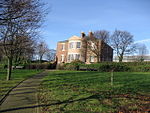St Bedes Junction rail crash
St. Bedes Junction lies between Jarrow and Bede Metro stations on what was the North Eastern Railway line between Newcastle upon Tyne and South Shields. From the junction, a mineral line descends on a gradient of 1 in 100 to Tyne Dock Bottom. On 17 December 1915, in the early morning in fog, a goods train ran out onto the main line past St Bedes signalbox having been banked in the rear up the incline by a six-coupled tank engine. The banking engine, uncoupled, dropped away from the goods train and came to a stand on the up main line, but was not seen by the signalman. Shortly afterwards, the signalman accepted the 07:05 passenger train from South Shields to Newcastle on the up line and the 06:58 empty stock train from Hebburn to South Shields which was travelling at about 10 mph (16 km/h). The passenger train collided with the rear of the banking engine at 30 mph (48 km/h), telescoping the two leading coaches. Almost immediately the empty stock train collided with the wreckage, killing the fireman. A subsequent enquiry suggested that 18 people lost their lives instantaneously during the collision. The gas-lit passenger coaches were then consumed by fire. 81 people were injured.
Excerpt from the Wikipedia article St Bedes Junction rail crash (License: CC BY-SA 3.0, Authors).St Bedes Junction rail crash
Prince Consort Road, South Tyneside
Geographical coordinates (GPS) Address Nearby Places Show on map
Geographical coordinates (GPS)
| Latitude | Longitude |
|---|---|
| N 54.9773 ° | E -1.4824 ° |
Address
Prince Consort Road
Prince Consort Road
NE32 5XX South Tyneside
England, United Kingdom
Open on Google Maps








